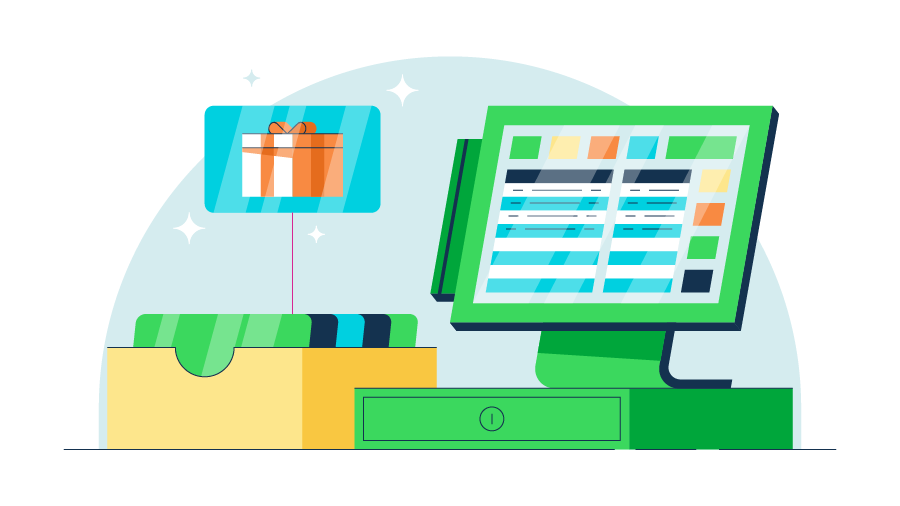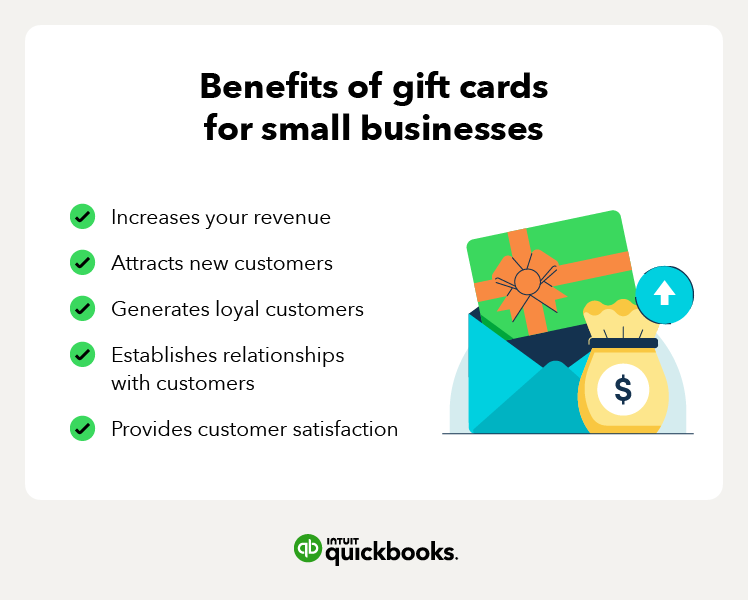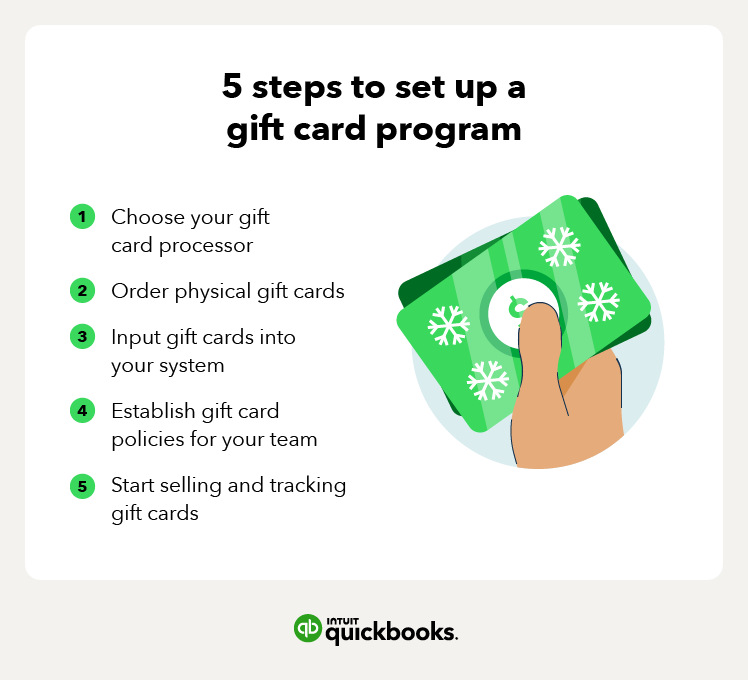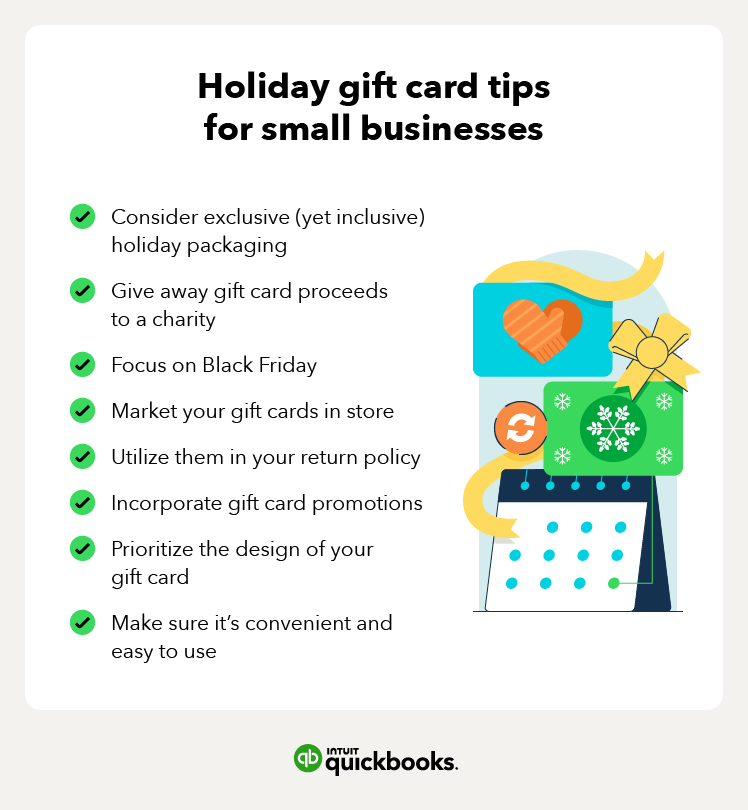

From boosting sales to building brand awareness, implementing a gift card program for your business has many perks. If you’re looking for new ways to drive profits, a gift card program may be for you. Whether you’re a bakery, clothing store, or beauty salon, a gift card program can be beneficial in many ways, especially during the upcoming holiday season.
Before you start your gift card program, be sure to familiarize yourself with the applicable federal regulations.
Read more to learn about how to set up a gift card program, different options available, how to set them up, and tips to maximize your gift cards.

There are many reasons why you should consider setting up a gift card program. Some benefits include:
Read on to learn how to set up a gift card program for your small business.
It may seem like all gift cards are the same, but there are different variations for each type of program. The types of gift card programs for small businesses include:
Learn more about these gift card programs below.
Open-loop gift cards are cards that customers can purchase at one location but use them at multiple locations. Common examples include Visa or Mastercard gift cards provided by select vendors.
Other variations of open-loop gift cards include:
Pros:
Cons:
Closed loop gift cards are gift cards that customers can only purchase and use at your business. These gift cards provide less flexibility to the consumer but more profit to the small business issuing them. Typically, closed-loop gift cards are free to activate—neither the small business owner nor the customer has to pay additional fees.
There are also two additional types of closed-loop gift cards:
Pros:
Cons:

Looking to add gift cards to your small business? Learn how to jumpstart your gift card program in five simple steps.
First, choose how you plan to process your gift card orders. For many small businesses, the easiest option might be to use whatever gift card option is in their point of sale (POS) system.
You can also purchase them from vendors and create a new “item for sale” in your POS system. Another option is to buy them through a bank that offers the service. Once you choose how you’ll process cards, you’ll need to order them.
By partnering with your POS system gift card provider, you may be able to offer gift card purchases online. Just like any e-commerce transaction, items are processed online. When customers are ready to purchase in-store or online, they can print electronic cards or show them to you on their smartphones.
With ecards, your business may have to cover a small payment processing fee (usually around $0.30). These gift cards will usually appear as a barcode, an identification number, or both.
While a bit of an old-school option, you can use gift certificates if you don’t have a POS system that can track gift cards. Instead, you can print your certificates and track purchases in a digital ledger or create a new line item in your POS system.
Some businesses also use a mix of gift cards and gift certificates. For example, a spa might offer a gift card for any purchase and a certificate for a “free massage.” However, gift certificates can be easy to counterfeit and aren’t the safest or most reliable option.
The last option is a physical gift card or plastic gift cards that you will order from your POS provider , a merchant bank, or a third-party gift card vendor. These cards often look like credit cards with magnetic strips, barcodes, and identification numbers.
Many vendors will provide you with customizable options to include your brand information on the card. Although they can be a pricer option, customers may prefer the physical card over a paper certificate or ecard.
If you have a physical location , you’ll need to order gift cards. You can do this through a third party or a vendor depending on your preferences. Ensure that you customize your order to include your brand logo, company name, preferred design, and any other details.
Tip: Ordering gift cards in bulk reduces costs.
Each POS system will have a different method for inputting your cards, but they’re all similar. Most commonly, you’ll just scan or swipe a blank card. Then, you’ll be prompted to choose the amount of money for that card.
Your customer pays the amount on the card to complete the transaction. When customers come in to use a gift card, the gift card should appear as an option for tender in your POS system.
Once you have your POS system set up for gift cards, educate your team on how it works. Share how to process gift card transactions and how customers can make purchases with gift cards. You’ll also want to inform them of any limitations you have on gift cards. Policies might include:
Other things to consider are how to track purchased cards and set expiration dates that follow federal guidelines.
Now that your staff is on the same page about the rules surrounding the gift card program, you can start selling gift cards online or in your store. If your POS system allows, you might track gift cards by attaching them to customer profiles in your system.
With so many gift card system options, it may be daunting to figure out which one is right for you. Ask yourself the following questions to help you choose the best gift card processor for your small business.
You should ask yourself if the platform you want to choose will be able to support your business, both currently and in the future. Certain platforms support a different number of gift card options.
For example, if you’re a small business that’s just starting out, you may only need one or two different platforms. If your small business is rapidly growing and is of a larger size, you may want to choose a platform that can support a wider range of gift card options and campaigns.
Determine what type of gift cards you want your small business to sell—this may help you figure out what software is best suited for you. For example, do you want to sell only physical gift cards?
Consider how your customers are obtaining your gift cards. Is your business only in-store? Do you have an online store? Both? You will need a gift card processor that is available for the right customer base.
Also, consider location. For example, if you’re supporting a gift card program for people throughout the United States versus just one or two cities, you’ll want to ensure that the gift card platform will work for people who live in various locations and can be delivered to them.
Gift card sales are part of the overall customer experience. To boost customer satisfaction, you may want to pair your program with other tools to help you gather analytics and other insights on customer behavior and sales patterns.
For example, if your small business has customer relation management (CRM) software, you may want to choose a gift card platform that can integrate with that tool.
There are many POS systems that offer gift card capabilities. Below are some examples of gift card POS systems that you can integrate into your small business.
Square is a POS that has online gift card capabilities. If your small business already uses Square, it can be especially easy to integrate this gift card program—and it’s free to set up.
Physical gift cards are also offered through Square—custom gift cards are an option as well. Square is also a closed-loop gift card program.
Cost: Free to use; 2.9% + $0.30 processing fee per gift card
Lightspeed is another POS system that offers gift cards in an open-loop program. In addition to selling digital gift cards and physical gift cards, this software also issues printable barcode gift cards and promotional gift cards, and allows gift card tracking, history, and details.
Cost: $69/month for the terminal; 2.6% + $0.10 processing fee per gift card
Revel is a POS system that offers personalized onboarding and is great for small businesses of all sizes. Revel also provides gift cards that customers can reload, as well as tracking and reporting capabilities. Revel offers a closed-loop gift card program.
Cost: $99/month for the terminal; 2.49% + $0.15 processing fee per gift card

Gift cards are in high demand during the holidays—especially for shoppers who are looking for a last-minute gift. In fact, about 48% of all gift card sales occur in December. With that being said, it’s essential to take advantage of the festivities and increase your sales during the holidays .
Below are some considerations for holiday gift cards:
Each holiday season, aim to have a unique gift card design or gift card sleeve. Think of this as similar to Starbucks' holiday cup designs. To stand out from the crowd, you can also consider using sustainable packaging .
For the holidays, consider donating a portion of your gift card proceeds to a charity, such as Make-A-Wish. Other popular charities for small businesses to donate to include:
Black Friday is a massive holiday for retailers and gives customers a head start on holiday shopping. Be sure to run gift card promotions for this day.
This doesn’t only apply to retailers; you can still take advantage of gift cards for your services. Also keep these considerations in mind for other holidays and events, such as Valentine’s Day, Mother’s and Father’s Day, store anniversaries, and more.
Make sure that you plan ahead for the holiday season and plan your designs and release date. This will help you avoid last-minute holiday stress. September and October are the calmer months before holiday festivities are in full swing, so consider your holiday gift card planning then.
You can also look at data from previous holidays—this can help you determine when the best time to launch your gift card holiday line is.
Additionally, be sure to print out these holiday-themed gift card holders below to have in your store or to add to an existing gift card you want to give someone.

Looking to get the most out of your gift card program? Here are several tips to ensure your small business maximizes sales with gift cards.
Make sure customers notice your gift card program by marketing it within your store, whether it be a physical location or online. To do this effectively, you can:
Note: To further market your gift cards , consider adding a link in your email template that points users to your gift card page.
If a customer doesn’t have a receipt with them and they want to return a product, you can use gift cards as a way to mitigate the issue and also give them a reason to continue to shop at your store—the customer is happy that they got to return their product and you still benefit from their business in the future.
Note: Giving the customers a gift card instead of cash when they return products without a receipt can help reduce fraud.
You can also use gift cards as part of a promotion or marketing campaign. To do this, you can reward your customers with a gift card if they spend a certain amount at your store.
Additionally, if you’re looking to phase out a product from your store, you can use gift cards as a way to entice customers to buy that particular product.
Note: A gift card promotion can include giving away a $20 gift card to customers who purchase a specific pair of running shoes from your workout line.
Looks matter when it comes to gift cards—making sure that the design of your gift card, like the sleeve that holds it, is eye-catching and well thought out to help motivate customers to purchase them.
This helps too when people are looking for a gift card to give someone—no one wants to receive a lackluster gift card. When designing your gift card, consider adding fun colors, images, textures, and typefaces all while making sure it fits with your brand’s style .
Note: You can even release a limited edition design so customers will be more motivated to get it before it’s gone.
Customers want gift cards to be easy to use. To make sure your gift card is convenient for the customer, you can ensure that the gift card:
Note: Be sure to give your shoppers more options and offer both physical and e-gift cards.
As your small business sells gift cards, you’ll be able to accept those profits upfront and reap the benefits, especially during the holiday season. Gift cards can be a helpful payment method for customers and a great way to generate extra cash flow—your customers will be happy to support you and look forward to shopping with you in the future.
In addition to selling gift cards, your business can take advantage of QuickBooks Payments to help simplify how customers pay you.
Recommended for you
How to set up your business for online sales in 5 easy steps

How to monetize a website: 8 ways to drive revenue and build a brand
January 28, 2020

Accepting advance payments: What is advance billing?
February 24, 2021
We provide third-party links as a convenience and for informational purposes only. Intuit does not endorse or approve these products and services, or the opinions of these corporations or organizations or individuals. Intuit accepts no responsibility for the accuracy, legality, or content on these sites.
**Product information
QuickBooks Live Assisted Bookkeeping: This is a monthly subscription service offering ongoing guidance on how to manage your books that you maintain full ownership and control. When you request a session with a Live Bookkeeper, they can provide guidance on topics including: bookkeeping automation, categorization, financial reports and dashboards, reconciliation, and workflow creation and management. They can also answer specific questions related to your books and your business. Some basic bookkeeping services may not be included and will be determined by your Live Bookkeeper. The Live Bookkeeper will provide help based on the information you provide.
QuickBooks Live Full-Service Bookkeeping: This is a combination service that includes QuickBooks Live Cleanup and QuickBooks Live Monthly Bookkeeping.
1. QuickBooks Online Advanced supports the upload of 1000 transaction lines for invoices at one time. 37% faster based off of internal tests comparing QuickBooks Online regular invoice workflow with QuickBooks Online Advanced multiple invoice workflow.
2. Access to Priority Circle and its benefits are available only to customers located in the 50 United States, including DC, who have an active, paid subscription to QuickBooks Desktop Enterprise or QuickBooks Online Advanced. Eligibility criteria may apply to certain products. When customers no longer have an active, paid subscription, they will not be eligible to receive benefits. Phone and messaging premium support is available 24/7. Support hours exclude occasional downtime due to system and server maintenance, company events, observed U.S. holidays and events beyond our control. Intuit reserves the right to change these hours without notice. Terms, conditions, pricing, service, support options, and support team members are subject to change without notice.
3. For hours of support and how to contact support, click here.
4. With our Tax Penalty Protection: If you receive a tax notice and send it to us within 15-days of the tax notice we will cover the payroll tax penalty, up to $25,000. Additional conditions and restrictions apply. See more information about the guarantee here: https://payroll.intuit.com/disclosure/.
Terms, conditions, pricing, special features, and service and support options subject to change without notice.
QuickBooks Payments: QuickBooks Payments account subject to eligibility criteria, credit, and application approval. Subscription to QuickBooks Online required. Money movement services are provided by Intuit Payments Inc., licensed as a Money Transmitter by the New York State Department of Financial Services. For more information about Intuit Payments' money transmission licenses, please visit https://www.intuit.com/legal/licenses/payment-licenses/.
QuickBooks Money: QuickBooks Money is a standalone Intuit offering that includes QuickBooks Payments and QuickBooks Checking. Intuit accounts are subject to eligibility criteria, credit, and application approval. Banking services provided by and the QuickBooks Visa® Debit Card is issued by Green Dot Bank, Member FDIC, pursuant to license from Visa U.S.A., Inc. Visa is a registered trademark of Visa International Service Association. QuickBooks Money Deposit Account Agreement applies. Banking services and debit card opening are subject to identity verification and approval by Green Dot Bank. Money movement services are provided by Intuit Payments Inc., licensed as a Money Transmitter by the New York State Department of Financial Services.
QuickBooks Commerce Integration: QuickBooks Online and QuickBooks Commerce sold separately. Integration available.
QuickBooks Live Bookkeeping Guided Setup: The QuickBooks Live Bookkeeping Guided Setup is a one-time virtual session with a QuickBooks expert. It’s available to new QuickBooks Online monthly subscribers who are within the first 30 days of their subscription. The QuickBooks Live Bookkeeping Guided Setup service includes: providing the customer with instructions on how to set up chart of accounts; customized invoices and setup reminders; connecting bank accounts and credit cards. The QuickBooks Live Bookkeeping Guided Setup is not available for QuickBooks trial and QuickBooks Self Employed offerings, and does not include desktop migration, Payroll setup or services. Your expert will only guide the process of setting up a QuickBooks Online account. Terms, conditions, pricing, special features, and service and support options subject to change without notice.